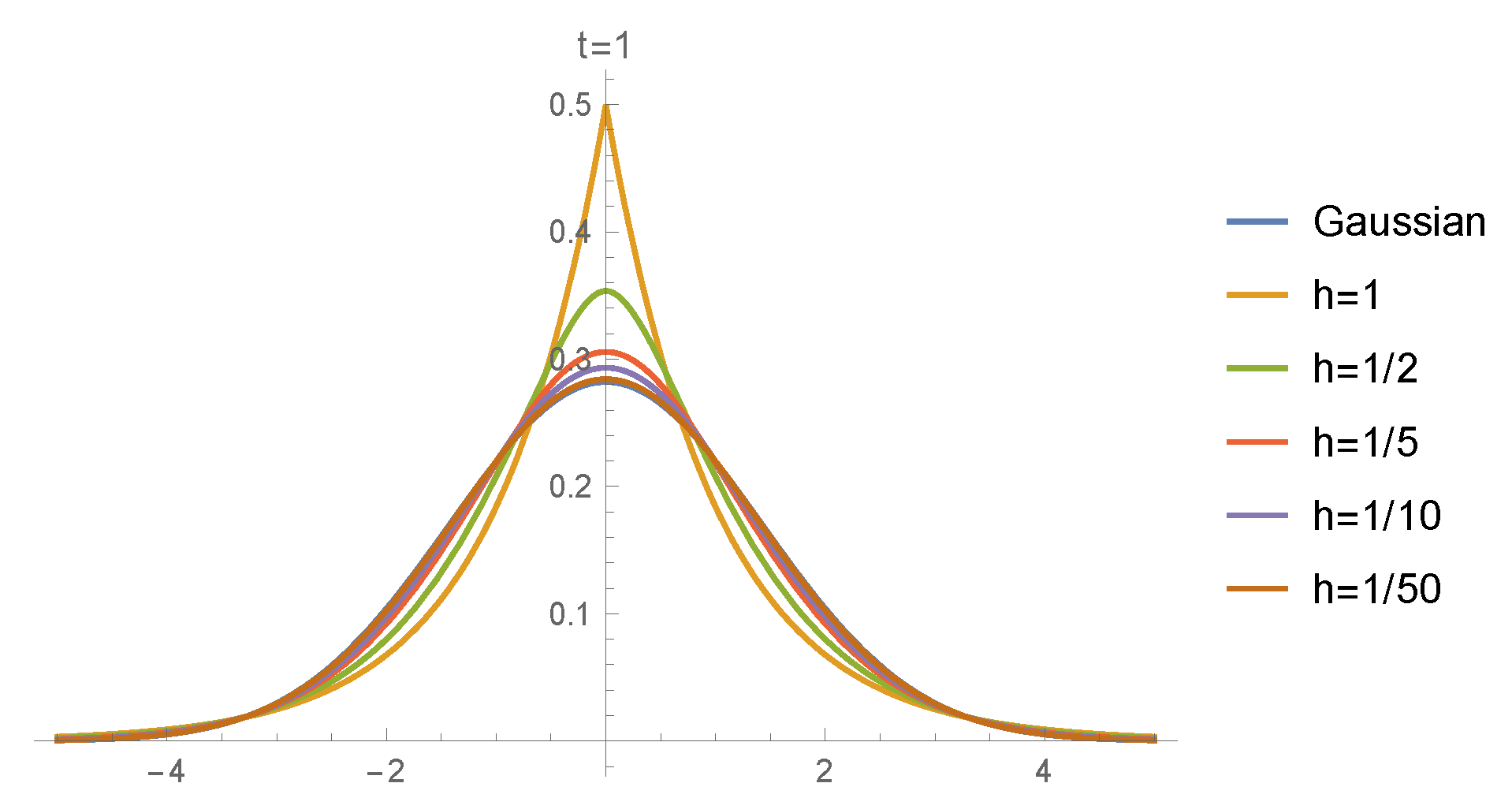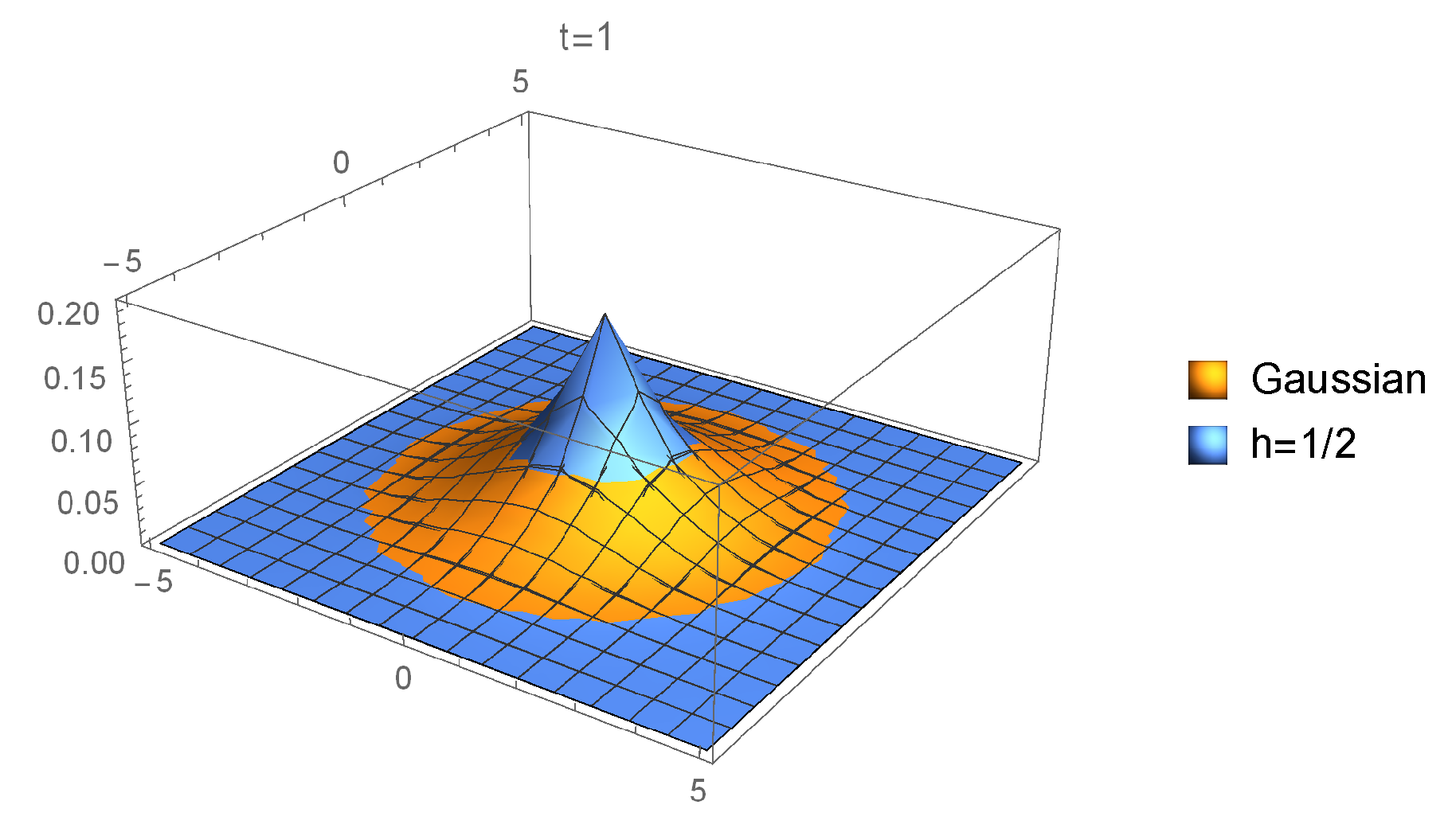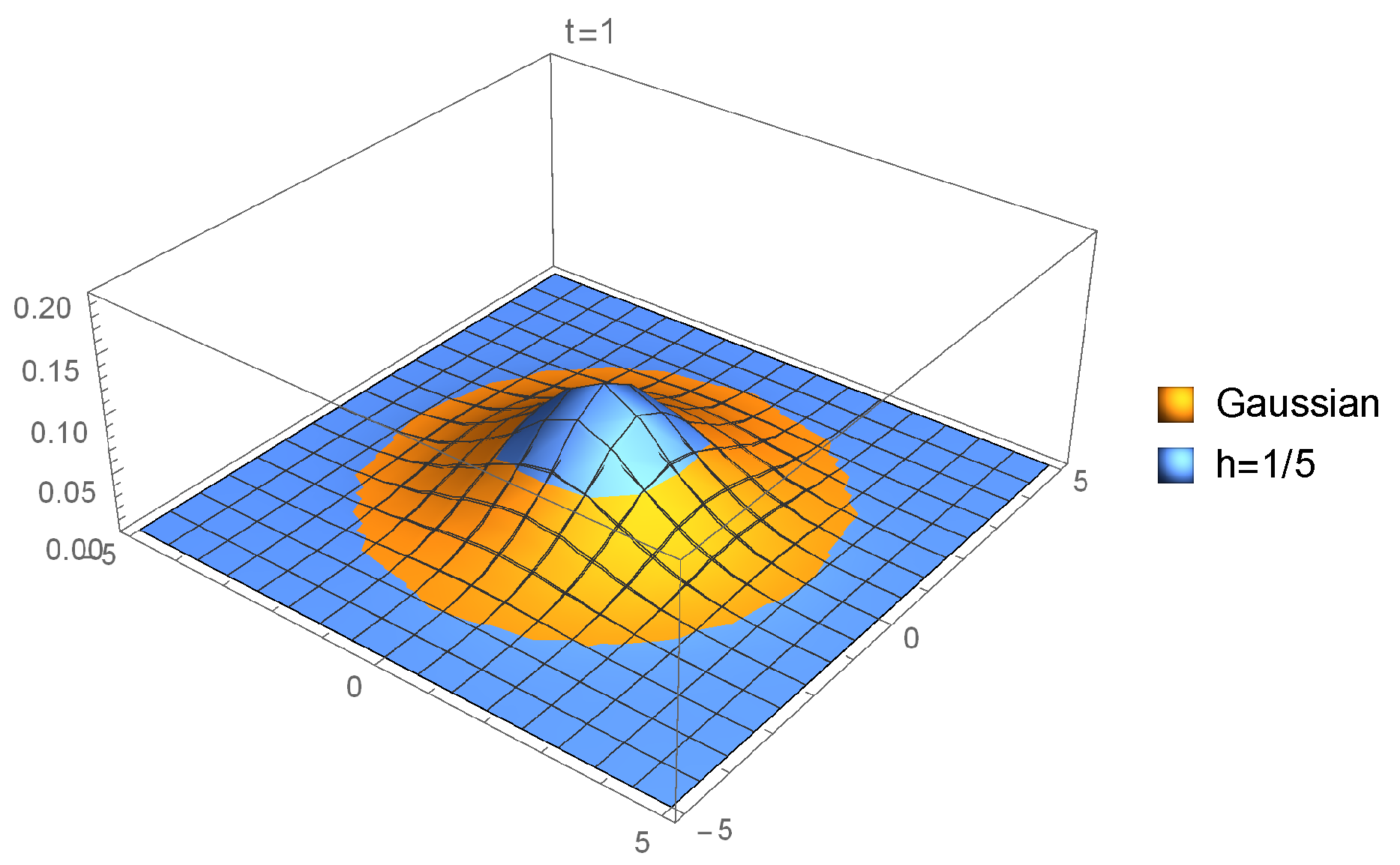1. Introduction
The linear heat equation
is one of the most studied problems in the theory of partial differential equations. It was introduced by J. Fourier (see [
1]) to model several diffusion phenomena. Since then, it has been applied in the study of different processes in many mathematical areas such as PDEs, functional analysis, harmonic analysis, probability, among others. The nature of this problem is well known and we will not further explain it.
One of the aspects of interest, see [
2,
3,
4], is the large-time behavior of solutions of the heat problem
where the Laplacian operator
is taken on the spatial variable(s)
. If
the solution of (
1) on
is
where ∗ denotes the classical convolution on
and
is the heat kernel. It is known that integrating over all of
, we get that the total mass of solutions is conserved for all time, that is,
This fact leads us to think that the total mass of solutions should have importance in the asymptotic behavior of solutions. Indeed, it is well known that if
then
for
where
is the classical norm on
. The previous estimate shows that the difference on
between the solution
and
decays to zero like
as
t goes to infinity.
It is also known that the
p-norms of the solution vanish as
for
This fact is known the fact of the
p-energy not being conservative. More precisely,
for
One can consider the first moment as the vector quantity
It can be seen that such moment is also conserved in time for the solution of (
1) whenever
that is,
To prove the previous identity it is enough to use that
and that
for all
Moreover, under such assumption, for each
there is
such that
see, for example, equation (1.11) in [
5]. However, if
observe that
and integrating by parts, we obtain
where we have used that
for
Thus,
and the second-order moment is not conservative. In fact, it is known that only integral quantities conserved by the solutions of (
1) are the mass and the first moment.
This type of large-time asymptotic results have been also studied for several diffusion problems. For example, in [
5,
6,
7,
8,
9], the authors studied large-time behavior and other asymptotic estimates for the solutions of different diffusion problems in
and similar aspects are studied for open bounded domains in [
7,
10]. Estimates for heat kernels on manifolds have been also studied in [
11,
12,
13]. In [
14], the author obtains Gaussian upper estimates for the heat kernel associated to the sub-Laplacian on a Lie group, and also for its first-order time and space derivatives.
On the other hand, finite differences, sometimes also called discrete derivatives, were introduced some centuries ago, and they have been used along the literature in different mathematical problems, mainly in approximation of derivatives for the numerical solution of differential equations and partial differential equations. The most knowing ones are the forward, backward and central differences (the forward and backward differences are associated to the Euler, explicit and implicit, numerical methods). We denote them in the following way: let
for a function
u defined on the mesh
we write
and
In the last years, and taking as a guide the paper [
15], several authors have been working in the context of partial difference–differential equations (see [
16,
17,
18,
19,
20,
21]) from a specific point of view; in these papers, the approach is focused on mathematical analysis, more precisely, harmonic analysis, functional analysis and fractional differences. Particularly in [
16], it is shown that the operators
and
generate Markovian
-semigroups on
Additionally, in [
18], the authors study harmonic properties of the solution of the heat problem on one-dimensional graphs (the mesh
), and the wave equation on graphs is studied in [
21]. An abstract approach for discrete in time Cauchy problems is given in [
20]. Furthermore, non-local problems in the discrete framework appear in [
17,
19].
Motivated by the importance of the classical heat problem (
1) and the knowing of the numerical approximations of the solutions of evolution problems, we consider the first-order Cauchy problem for the heat equation in discrete time
with
where
is the classical Laplacian on
(taken on the spatial variable(s)
x),
u is defined on
, with
,
f is defined on
and
g is defined on
with
Along the paper, we study asymptotic behavior and decay of the solution of (
3). For that purpose, we need to know properties of the fundamental solution of the homogeneous problem associated to (
3) (when
). In fact, one of the key points to obtaining such asymptotic properties is an integral representation of the fundamental solution for the associated homogeneous equation. Furthermore, we describe explicitly this solution in terms of MacDonald’s functions which arise naturally from the integral representation of the solution. This representation is quite original and allows to study the decay of solutions for the problem (
3) when the initial datum belongs to
p-integrable Lebesgue spaces. Moreover, both the integral representation and the explicit expression via MacDonald’s functions allow to give a quantitative rate at which the solution converges to
M times the fundamental solution, where
M will denote, as in the continuous case, the initial mass of solution. The techniques used to obtain our results differs to the continuous case because we have to deal with the integral representation and asymptotic properties of MacDonald’s special functions. We also note to the reader that obtaining the relation
the asymptotics of
will be similar to
as
or equivalently
where
will denote the fundamental solution of the homogeneous problem associated to (
3).
One can think about the possibility of studying similar problems to (
3) but considering the discrete derivatives
or
However, as we explain in Remark 2, the fundamental solutions to that problem do not have good properties.
The paper is organized as follows.
Section 2 is focused on the fundamental solution of the homogeneous problem associated with (
3). We introduce an integral representation (
5) and the explicit expression via MacDonald’s functions (
6). We deduce basic properties, we calculate its gradient and Laplacian, and we see that the mass and the first moment of solutions of the homogeneous problem are conservative in discrete time
and not the second moment. Furthermore, some pictures of the continuous and discrete Gaussian kernels, with their corresponding comments, are stated. In
Section 3, we give pointwise estimates (Theorem 1) and
asymptotic upper bounds (Theorem 2) for the fundamental solution
and we use such estimates to prove in
Section 4 that the
p-energies of solutions of (
3) are dissipative (Theorems 3 and 4).
Section 5 is the main part of the paper; we prove the asymptotic behavior for the discrete in time heat problem (Theorem 5). In
Section 6, we succeed in proving optimal
-decay estimates for the solution of the homogeneous problem associated to (
3) (Theorem 6). The proof is based on Fourier analysis techniques. Finally, we include an Appendix (
Appendix A) where we show some basic properties of Gamma and MacDonald’s functions, and a technical result about integrability.
2. The Discrete Gaussian Fundamental Solution
In this section, we study the fundamental solution for the homogeneous discrete in time heat initial value problem on the Lebesgue
spaces. Let
we consider
where
u and
f are functions defined on
and
, respectively. Formally, one can write the solution in the following way
whenever the resolvent operator
has sense. It is well known that the Laplacian operator
associated with the standard heat equation in continuous time on
for
generates the Gaussian semigroup
where ∗ denotes the classical convolution on
and
is the convolution kernel which is given by
From semigroup theory (see Chapter 3, Corollary 1.11 (equation (1.16) ) in [
22]), we obtain
Remark 1. Note that fixed a positive number the approximants given by the Post-Widder inversion formula (see Chapter III, Section 5, Corollary 5.5 in [22]) allow to approximate the Gaussian -semigroup as That is, for uniformly for t in compact intervals. Writing the previous convergence shows that the Gaussian semigroup can be approximated by the solutions of the discrete in time problems (4), i.e., as the mesh Remark 2. It is easy to see that if we consider the forward difference on (4), then formally, the solution of the problem would be which is not defined (bounded) on Additionally, for the central difference , the fundamental solution would be given bywhere are the Bessel functions of the first kind. In this case, it is not difficult to prove that the solution is bounded on however, it does not have as good properties as satisfies, for example, the contractivity on These are the main reasons we consider the discrete in time heat problem with the backward difference
Now, we will see the explicit expression of the fundamental solution
in terms of special functions. By [
23] (p. 363 (9)), we have
Here, the functions
denote the Bessel functions of imaginary argument, also called MacDonald’s functions or modified cylinder functions (see
Appendix A). Observe that the identity has no pointwise sense for
if
In fact, for that values
, taking
in (
6) and using (P4), (P6) and (P8) of
Appendix A one obtains
For the case
by (P4), we have
as
Remark 3. The Gaussian kernel satisfies the semigroup property on time, . Since is given by natural powers of the resolvent operator of the Laplacian, it satisfies the discrete semigroup property. Indeed, we also can prove that property using the expression (5) as follows, Here, is the Beta function.
In the following, we denote
The above integral representation is a discretization formula for the Gaussian semigroup. The case
was treated in [
20] for a general
-semigroup on an abstract context.
Next, we refer to the function
as the
fundamental solution for the problem (
4). The following proposition states some basic properties of it.
Proposition 1. The function satisfies:
- (i)
- (ii)
;
- (iii)
- (iv)
- (v)
Proof. (i) It is clear by (
7). (ii) Note that
and
then the result follows from the Fubini’s theorem. (iii) It is known that
, for
then by (
7) one obtains
(iv) First of all, observe that
for
Then, integrating by parts, we obtain
where we have used that
and
(v) It follows easily by the second moment of
and the representation (
5). □
Remark 4. Observe that one can prove the above properties via the expression (6) given by the MacDonald’s function. For example, from (P1) of Appendix A we get the positivity of the fundamental solution. Furthermore, by [23] (p. 668 (16)), it follows We also note that by and (P2) of Appendix A, we obtainand then derivating once more in the previous expression and taking into account (P3) and (P7) (with ) of Appendix A, we have Now, since , we obtain Finally, observe that the mean square displacement can be also calculated in the following way; using (6), a change of variables and [23] (p. 668 (16)), we have Remark 5. Note that by Proposition 1 (ii), we have that the total mass of solution of (4) is conservative in the discrete time that is, Moreover, the first moment is also conservative: if one getsand so However, as in the continuous case holds, by Proposition 1 (v), it follows that if , the second-order moment is To finish this section, we show some pictures of the fundamental solution of (
4). We have used Mathematica to make them. The objective is that the reader visualizes the convergence of
to
as the mesh
Figure 1 shows, in the one-dimensional case (
), the Gauss kernel
and the fundamental solutions of the discrete problems for several values of
As we have mentioned, the approximants in the Post-Wider inversion formula (which are given by the fundamental solutions in the discrete setting) converge to the Gaussian semigroup as
writing
Therefore, for the different values of
we choose
n such that
For example, for
, we have represented the fundamental solution
Furthermore, observe that for
the fundamental solution
is defined on the whole real line since
for all
However, by (
8), and (P6) and (P4) of
Appendix A, we obtain
where
is a positive constant depending on
h (the symbol ∼ denotes that both functions are equivalent in the limit, in this case, as
). This shows that
is not derivable in
(see
Figure 1 for
).
Figure 2,
Figure 3 and
Figure 4 show several approximants to the Gaussian
in the two-dimensional case (
). In
Figure 2, we observe that
taking
as we have commented previously (since
for
).
In
Figure 3 we glimpse that
is well defined for
but it is not differentiable (since
). Finally,
Figure 4 shows, not only as the approximation improves as
h decreases, but also that the function is smoother.
5. Large-Time Behavior of Solutions
In the following, we study the asymptotic behavior of solution of (
11), more precisely we will prove as the solution
converges asymptotically to a linear combination of the mass of the initial data
f and the mass of the non-homogeneity
Moreover, we will be able to state the rate of the convergence. Along the section, we will assume the following:
- (a)
.
- (b)
There exists
such that
Next, we consider the intervals
(depending on
) of values of
p, for which the following result will be valid. We define
Taking into account the previous notation, we present the next theorem.
Theorem 5. Let Assume the conditions – and let and given by (13) and (14), respectively. If then for all - (i)
- (ii)
Suppose, in addition, that then there exists such that
Proof. Note that by Theorems 3 and 4, we have that when that is, when
We start proving the assertion
. Next, we can assume that
n is large enough. Since
by Decomposition Lemma A1 there exists
such that
in the distributional sense, and
Then,
which implies (
n large enough such that
)
where we have used part
of Theorem 2. This implies
To prove the first part of assertion
, we choose a sequence
such that
for all
and
in
. For each
j, by Theorem 2 and (
15) we get
It follows that
which implies
The assertion follows by letting .
Next, let us prove the second part of
. We can write
It follows from Theorem 2 that
Therefore, it is enough to show the following
Ir order to prove the assertion, we fix
In particular, this implies that
and
Next, we decompose the set
into two parts
Let us start with the set
. By the integral form of the Minkowski inequality, we obtain
Note that in this set, the following inequalities hold:
where the second inequality follows from
Now, when
we consider the following subsets over
and we write the
p-norm over
in the following way
Let us estimate on
the part
A of the
p-norm. First, we write
For
and
, we have that
Since we want to estimate the solution for large values of
n, we can assume that
. Thus, (
16) implies that
It follows from Theorem 1 (i) that
Then,
where in the last inequality we have used (
16). Analogously, for
and
, we have
which implies that
Since
we get
Now, we consider on
the part
B of the
p-norm. We write
First, let us estimate
. By mean value theorem, there exists
between
and
x (
x denote the integration variable) such that
Since
, then
and
Equations (
17) and (
18) show that
and
are comparable. Furthermore, by (
16) and (
17), we obtain
Now, we will use the asymptotics of so we divide in two parts, and depending on whether is less or greater than 1, respectively (we are assuming to be small enough).
In
, when
, by (
18) one obtains
For this reason, the integration region in
is contained in
. From Theorem 1 (ii), the fact that
(
16) and (
17), we have
For
by (
19) note that the set of integration is contained in
Then, from Theorem 1 (ii) (by (
16) we can take
n large enough,
such that
), it follows
which is equivalent to
Next, let us estimate
. From discrete mean value theorem (see Corollary 2 in [
24]), there exist
(whenever
) and
such that
Recall that in
we have
which implies by (
16) that
Additionally, in
and
B, we have
so
and we have again two cases. We denote by
and
depending on whether
or
on the right side of (
20).
For
since
and
the set of integration is contained in
Then, from Theorem 1 (iii) (by (
16) we can take
n large enough,
such that
) and the fact that we are in
, we have
For
, we have
which implies that the set of integration is contained in
Then, by Theorem 1 (iii), we have
Collecting all above terms over
B, we obtain
for some positive number
. The upper bound tends to zero as
uniformly in
.
Now, we consider the set
. Then,
By Theorem 2 (i) (the condition
implies
) one gets
As , . This implies that has measure zero, and since then as . It follows that as .
For
, we have two possibilities: either
or
. Thus, we divide
Let us start with
. Recall that for
the expression (
16) holds. Therefore, by Theorem 2 (i) (the condition
implies
) we have that
as
Next, for
again by Theorem 2 (i),
and
we obtain
□









